Introduction
Water is a fundamental natural resource that is vital for the sustenance of all living beings. Throughout history, there have been many conflicts over access to the resource as its distribution and availability are influenced by diverse factors such as geography, climate, socioeconomic conditions, and politics. As societies worldwide grapple with unique challenges related to water management, many have adopted distinct approaches to water governance shaped by their contexts. Water management at the grassroots and institutional levels is pivotal in shaping social relations and interactions within communities. It encompasses a broad spectrum of activities, from collecting and allocating water resources to developing policies and governance structures that oversee water usage.
Notably, water management and governance practices vary significantly between developed and developing regions; even within developing countries, they can differ considerably based on local conditions and traditions.[1] At its core, water management is deeply intertwined with the social, economic, cultural, and political fabric of the regions it serves. Under specific contexts, while decentralisation of water management and/or the commodification of water into private goods may be effective, such initiatives are often constrained by the existing paradigms in culture, values, and institutions, including family life.[2],[3] For example, decentralising the authority over common resources such as village wells with the launch of the Panchayati Raj in India has had a differential impact on diverse local communities. Specific case studies have shown that community-led water, sanitation, and hygiene (WASH) infrastructure may not be immune to existing social inequities, with women from the poorest and lower caste households confronting significant constraints in accessing clean water.[4] The World Bank defines water resource management as a holistic process that encompasses planning, development, and the stewardship of water resources, encompassing quantity and quality, supported by institutions, infrastructure, incentives, and information systems.[5] Crucially, how societies govern their water resources directly impacts the livelihoods of their inhabitants. Water management can be observed at various levels: rural, urban, and transboundary. Rural areas typically rely on traditional, community-led water management practices rooted in indigenous knowledge. Meanwhile, urban regions employ more advanced technologies and infrastructure, such as tanks and taps, to meet their water needs. Water management also manifests as shared resources across transboundary basins where integrated water resource management and water diplomacy are crucial aspects of community life.
However, at the crux of all water management practices, regardless of the setting, lies a common and often overlooked reality—women and young girls play a central role in providing and managing water within households. They possess a profound understanding of local water resources, their locations, and their quality. Women are involved in tasks such as collecting, storing, recycling, and distributing water for various domestic purposes, including drinking, bathing, food preparation, and sanitation. Across the world, women spend up to 200 million labour hours on activities related to water management daily.[6]
Despite their indispensable role in water management, women are frequently excluded from critical decision-making processes related to water governance.[7] This exclusion results in ineffective water governance strategies and policies. At the same time, the intra-household division of labour and production organisation is poorly understood by institutions responsible for water governance. Consequently, the failure to consider gender dynamics during the planning and design phases undermines the effectiveness of otherwise well-intentioned policies. For instance, a study by the Asian Development Bank has shown that gender-responsive infrastructure development in Asia and the Pacific can potentially tackle the gender division of labour and significantly mitigate women's time poverty in the region, time that can be used for productive work that reduces their consumption poverty.[8]
Recognising the need for change, the Dublin-Rio Principles, adopted at the 1992 Rio Earth Summit, were instrumental in provoking gender-responsive interventions in water management worldwide. International organisations such as the United Nations Conference on Environment and Development have also taken concrete steps to highlight the impact of women's extensive involvement in water management.[9] Efforts have included training women in water pump operation and maintenance to improve access and empower them to take leadership roles within drinking water users' associations to enable gender-responsive solutions at an institutional level.
While water governance lacks a universally agreed definition, it essentially strives to address questions of who gets access to water, when, and who has the right to water resources. In recent years, organisations such as the United Nations, the World Bank, and the Global Environmental Facility have collaborated with governments, civil society organisations, the private sector, and academia to enhance gender mainstreaming in water governance efforts worldwide.[10] Effective water governance relies on robust gender-responsive institutional frameworks. In India, several challenges hinder the establishment of such a framework, including inadequate resource management, outdated infrastructure, insufficient human capacity, and ineffective institutional arrangements. At the core of these issues, however, lies a very restricted understanding of gender roles in water resources management at the household level and their implications on broader economic outcomes, such as capacity building, women’s labour force participation, employment rates, their economic empowerment, and gender equity in overall developmental outcomes.
India, a water-stressed country, faces significant disparities in water distribution, necessitating a comprehensive water management and governance strategy.[11] At the current pace of population growth, combined with existing water consumption patterns, India is expected to experience a daunting 40 percent deficit between projected demand and available usable water by 2030.[12] Moreover, the projected increase in agricultural production by 2050, also driven by population growth, is poised to consume a substantial portion of the available water resources, further exacerbating the crisis.[13]
Gender equality is pivotal in the context of water management and governance, and remains central to the 2030 Agenda for Sustainable Development. Women and girls—as the primary users, providers, and managers of water and sanitation at the household level—often bear the burden of water collection and treatment. This burden can expose them to multiple risks, including illness, harassment, and violence, thereby impacting their ability to participate fully in education and economic opportunities. The promotion of gender-responsive WASH policies is identified as a catalyst for broader change across the 2030 Agenda, including goals related to health, education, and economic growth.
To harness the synergies between WASH and gender equality effectively, women’s participation in decision-making related to water governance must be increased. This is crucial as decisions on large-scale infrastructure investments, water allocations, and water trading have traditionally been gender-blind. Despite being the primary decision-makers at the household level, women remain underrepresented in key water governance positions.[14] The limited inclusivity of gender perspectives in water management and governance impedes progress towards sustainable resource development and equitable water distribution.
Women, repositories of historical knowledge and expertise in water management, can significantly contribute to economic growth and development when actively engaged in decision-making processes. They exhibit a remarkable ability to share water resources equitably, particularly in times of scarcity.[15] The presence of women in institutions, such as water user associations, public water management bodies, and water committees, can lead to the design of more inclusive policies that address previously overlooked issues at the national policy level.
In 2011, Uganda implemented a five-year gender strategy for its water sector, placing women in key decision-making roles within committees. This initiative increased Ugandans' access to safe water from 51 percent to 61 percent in just two years, illustrating the potential for transformative change.[16] In 2021, India launched the Women Water Champions initiative, emphasising the critical role of women in water conservation and management and promoting their leadership in water governance. This initiative showcased the dedicated efforts of 41 women at the grassroots level who confronted water crises and addressed the complexities of water management.[17]
This paper delves into the intricate dynamics of gender, water management, and governance in India, exploring the implications for women’s economic participation in its labour markets. By examining women's roles in water management at the household level, the paper sheds light on the challenges, consequences, and potential strategies for promoting gender equality in this critical domain.
The Role of Women in Water Management in India
Gender roles in water management are deeply embedded in the context of power dynamics and access to resources across India. Political economy factors intersect with the distribution of the resource, and the fabric of social relations defines who, when, and how much water an individual or a community can claim as their own. In this complex web, gender relations are a significant factor that shapes how water resources are managed and governed across the landscape. While understanding the role of women in water management necessitates considering a multitude of socioeconomic and geographical conditions that influence their experiences, it also helps highlight the implications that the interplay of gender roles in water governance and women’s relative time poverty have had on the labour markets across the Indian states and union territories (UTs).
India's gender relations have historically placed women in a disadvantaged position. Traditional roles confined women's involvement in water management to the domestic sphere, where they were designated as the caretakers of domestic water resources. Their responsibilities encompassed procuring, managing, and storing water for various sanitation and domestic purposes. Women, thus, have held a vital role in ensuring that the water they procured was pure, uncontaminated, and readily accessible. Many factors influenced their decisions, including climate conditions, distance to water sources, and convenience. However, it is crucial to note that these practices were not uniform across India or in specific regions.
Upper-caste women often found themselves constrained in making water management decisions. In contrast, women from lower castes had to take on roles with greater mobility and shouldered the burden of fetching water from distant and sometimes unreliable sources.[18] Age also plays a significant role in shaping the gender dynamics related to water management. Older women, while less involved in the physical act of procuring water, often take on the role of decision-makers.[19] In the agriculture sector, women from lower castes make up a substantial portion of the workforce, influenced by historical land-ownership patterns and social relations in rural areas.[20] Nevertheless, their access and involvement in irrigation have remained limited, as women from upper castes are more likely to manage agricultural land in the absence of male heads of households and make crucial decisions on related farming practices.
To illustrate the profound impact of water scarcity on women's lives, consider Dengamal, a village in Maharashtra in western India.[21] The absence of water pipeline connections forces residents to rely on the Bhatsa dam, a 12-hour journey away, for their water needs. The time-consuming water collection process leaves women with insufficient hours to manage household chores effectively. As a solution, some households have resorted to polygamy to ensure an adequate water supply. Women who take up the role of "water wives" are often second or third wives, wielding no influence over their husbands and within the household. This leaves the ‘water wives’ with no social rights, and only dealing with their daily struggle of water collection responsibilities.
Besides social outcomes, women's extensive and disparate engagement in water management has direct economic implications. Time spent on unpaid work, particularly in the context of domestic chores, including procuring water and fuel for own use and that of household members, remains a significant yet often overlooked facet of gender disparities. Besides direct engagement in collecting and procuring water for a household’s final consumption, women’s role in water management encompasses several other related activities that depend on the allocation and use-efficiency of water as a resource. These often include activities such as food and meals management and preparation, cleaning and maintaining the family dwelling and surroundings, fetching water for farmland or domestic animals, the care and maintenance of textiles and footwear, and other household management activities. The burden of these activities disproportionately falls on women, contributing to the pervasive issue of time poverty.
The 2019 Time Use Survey (TUS) for India[22] provides valuable insights into the extent of such unpaid domestic services work and its implications on gender equality in India. As such, while activity groups 242 and 325 of the TUS record the time spent by surveyed individuals directly on activities related to water collection[a], indicating that this remains a principal activity status across several regions in the country, this paper adopts a more comprehensive approach to exploring the water management-induced burden of unpaid domestic services activities on Indian women. Taking into consideration the collective time spent on all activities defined under major divisions of the TUS activity classification[23]—“Production of goods for own final use” (major division 2) and “Unpaid domestic services for household members” (major division 3)—this author defines a proxy variable for “Water Management-related Unpaid Domestic Services” (see Table 1). While the TUS classifications considered here subsume some other activities that do not apparently reflect upon the households’ water management practices specifically, it is assumed that the time spent on such activities mimics the broader trends of labour division on other relevant indicators in this context and, therefore, does not introduce any bias to the insights of the study.
Table 1: Water Management-related Unpaid Domestic Services Activities
| Activity |
Description |
| Water Collection |
Gathering water from sources for household use. |
| Water Storage |
Storing collected water in safe and clean containers. |
| Water Treatment |
Purifying or filtering water to make it safe for consumption. |
| Water Distribution |
Allocating water for different household uses. |
| Water Usage |
Food, cleaning, care of textiles, pet care, and other activities. |
| Water Conservation |
Implementing measures to reduce water wastage. |
| Maintenance of Water Systems |
Ensuring the household water systems are functioning properly. |
| Monitoring Water Quality |
Checking the quality of water to ensure it's safe for consumption. |
| Financial Management |
Budgeting for water-related expenses, including bills and repairs. |
| Hygiene and Sanitation |
Ensuring hygiene and sanitation to prevent waterborne diseases. |
Source: Author’s own
The report paints a stark picture of the gendered nature of unpaid domestic services work, revealing that women in India spend a substantial amount of time on these activities, which take an average of nearly five hours each day to complete.[24] In contrast, men devote only about an hour and a half to these activities. In rural areas, women spend an average of 301 minutes daily on unpaid domestic services work, while men spend 98 minutes. In urban spaces, women spend 293 minutes on unpaid domestic services work, while men devote only 94 minutes. Figure 1 underscores the glaring gender disparities that persist in the participation rates in domestic services work, while Figure 2 highlights the disproportionate time that participating men and women across households spend on these activities on average per day.
Figure 1: Percentage of household members participating in water management-related unpaid domestic services
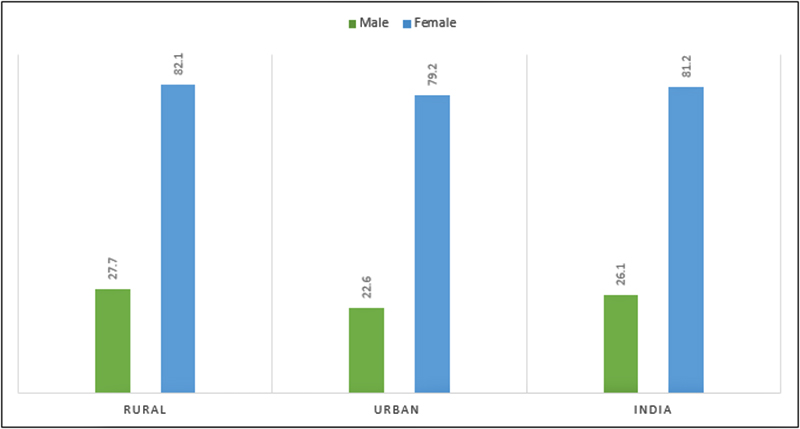
Source: Author’s own, data from India Time Use Survey 2019[25]
Figure 2: Average minutes in a day spent by participating household members on water management-related unpaid domestic services
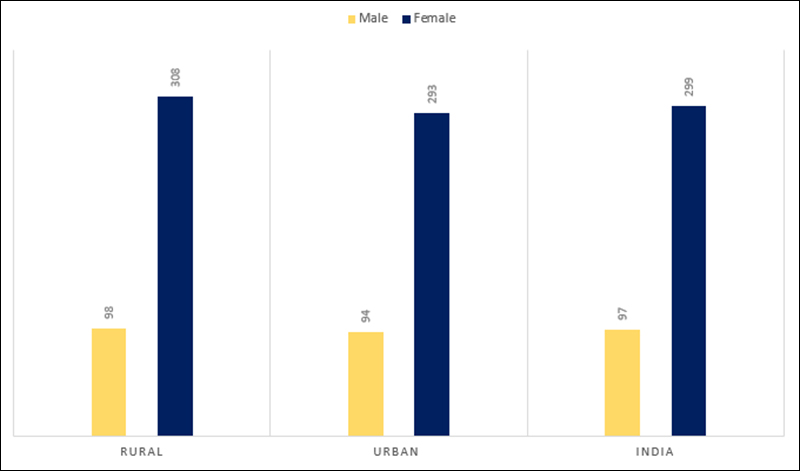
Source: Author’s own, data from India Time Use Survey 2019[26]
The complexities of gender roles in water management are significantly disparate across rural and urban India. At the national level, estimates suggest, all households without on-premises water facilities spent approximately 66.6 million hours each day on activities related to water collection, with rural households spending a disproportionate 84 percent of the aggregate time.[27] Therefore, women in regions across India with a relatively large rural population, limited water resources, and underserved infrastructure in the water sector are likely to face a significantly higher burden of water management roles. Even in urban areas, where nearly 20 percent of households lack access to drinking water facilities within their premises, women bear the primary responsibility for household water management.
This has profound economic implications. The TUS report reveals that women's disproportionate engagement in water supply and management results in what is termed "time poverty" for women, as they are left with significantly less time for personal development, leisure, or income-generating activities. This is significantly related to their ability to participate in paid employment or pursue educational opportunities. The inconsistency in water availability schedules compounds women’s workload. They often carry heavy loads of water and walk long distances, while men in the community may use bikes or bicycles for water collection. This undue burden on women takes a toll on their educational enrolment and attendance, and limits their participation in other paid economic endeavours. The relationship between water access, its management, and gender has direct implications on an individual's socioeconomic status and, therefore, the employment scenarios India witnesses across its states and UTs. Figure 3 provides a comparison between men and women across the Indian states and UTs using minutes spent in a day on an average per person in water management-related unpaid domestic services activities for household members aged 15-59 years.
Figure 3: Average time spent on water management-related unpaid domestic services across India
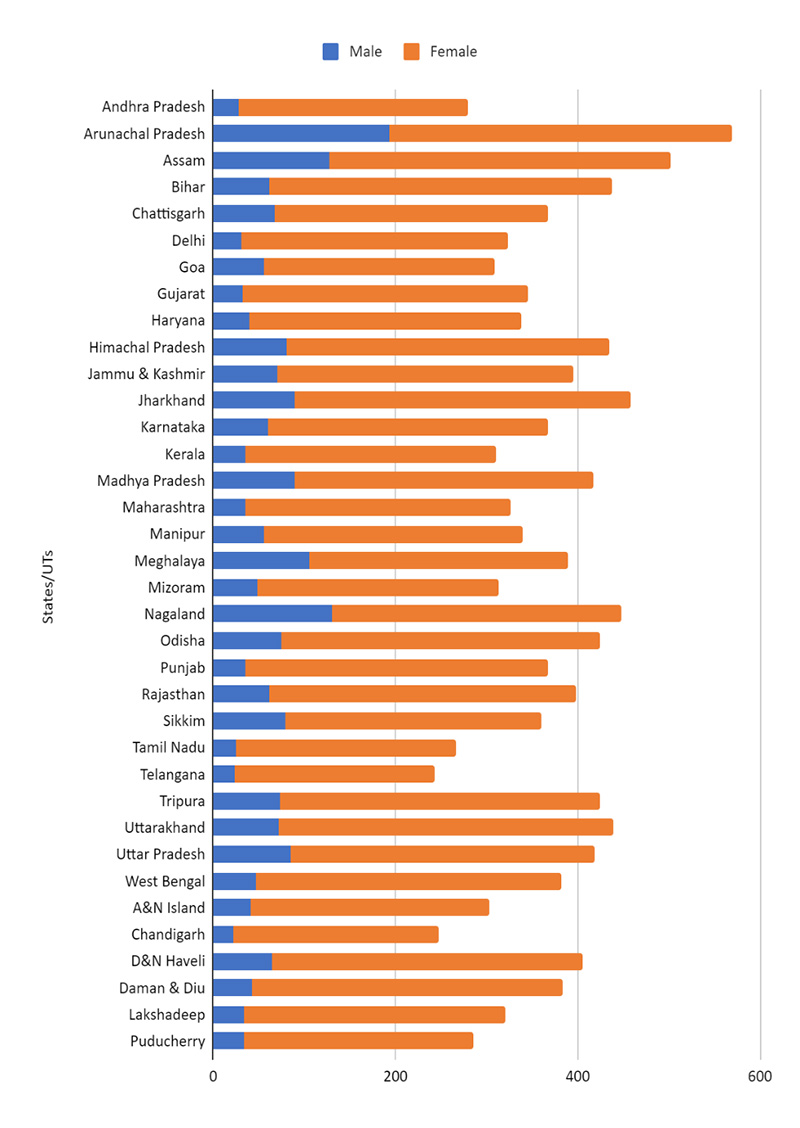
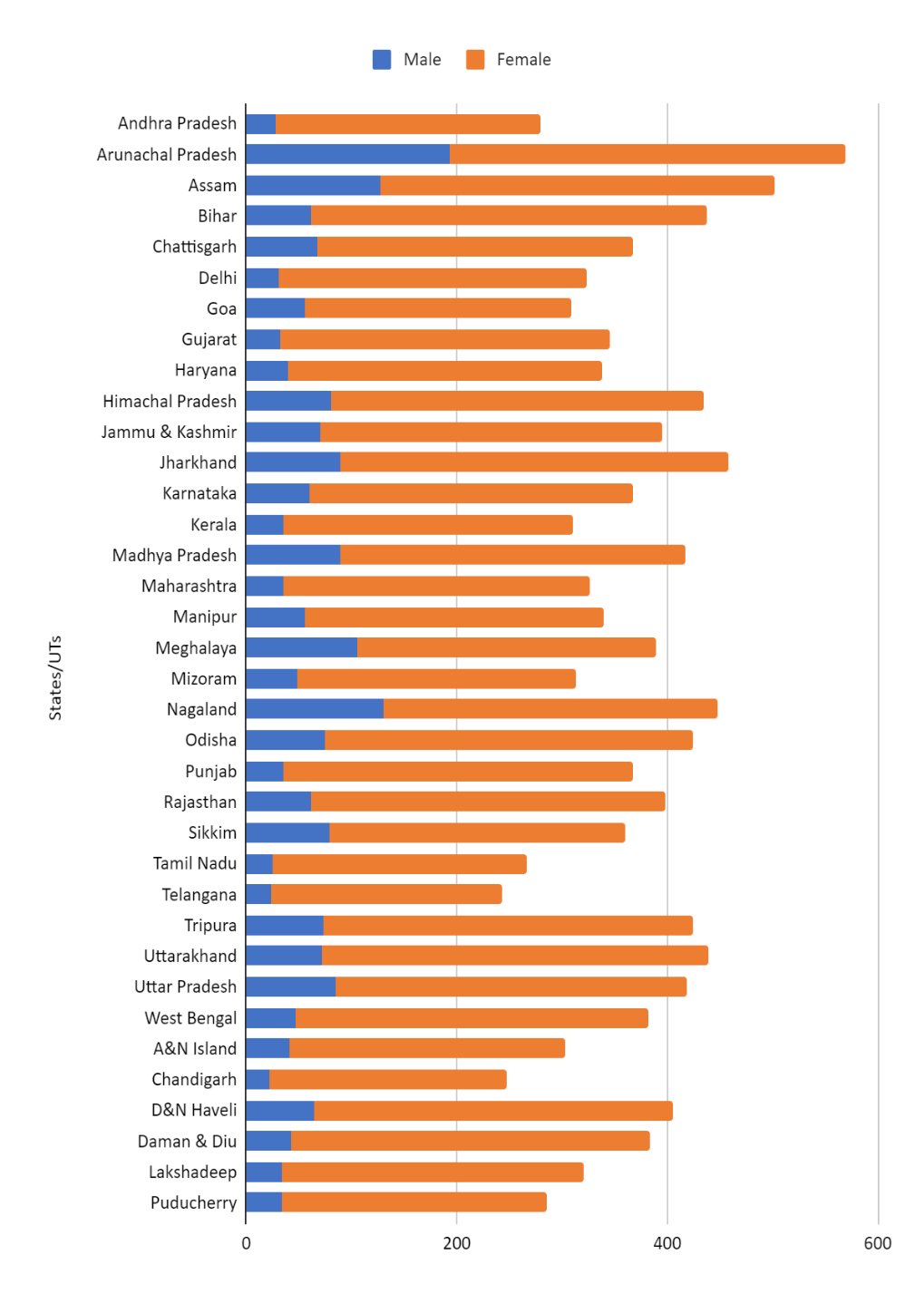
Source: Author’s own, data from India Time Use Survey 2019[28]
Unpaid household work, including water management and related activities, places a significant burden on women. This disparity in the allocation of domestic responsibilities impacts educational opportunities and limits women's potential for meaningful employment in the long term. This double burden results in reduced school attendance for girls and deprives women of the education necessary to secure gainful employment.[29] Women in the workforce dedicate additional time to unpaid domestic work, creating a taxing cycle that severely affects their wellbeing.
Implications for Indian Labour Markets and Household Income
Women’s time poverty has implications for the Indian labour markets and associated costs in terms of women’s economic participation. In recent years, India's declining female labour force participation rate has garnered significant attention.[30] Multiple factors have been attributed to this trend, including rising household income (the income effect) and challenges related to employment opportunities for women (demand segmentation). However, a critical yet often overlooked aspect in policy circles is burden of unpaid domestic service activities, such as work related to water management, on women and its role in shaping the female labour force participation rate. While care work and the need for care infrastructure have garnered some attention from stakeholders, including individuals, businesses, academicians and policymakers, domestic service activities and their role in implicating the labour markets or economic participation of individuals has remained only an additive component in the conversation. This is because an analysis of domestic services also necessitates a more nuanced understanding of several other critical sectors, such as energy, food, water and sanitation, and livelihoods.[31]
Besides the recognition and distinction between domestic care work and domestic services activities, it is also important to highlight that gender disparities in time spent on each category of related activities are also markedly different. Figure 4 below shows that the relative equity of time spent in a day by an average Indian man and a woman on activities related to unpaid domestic care work is significantly higher than unpaid domestic services. This further highlights the importance of focusing specifically on domestic service activities; this study focuses mainly on the water sector and its household-level implications.
Figure 4: Relative equity in time spent on unpaid care and domestic services across India
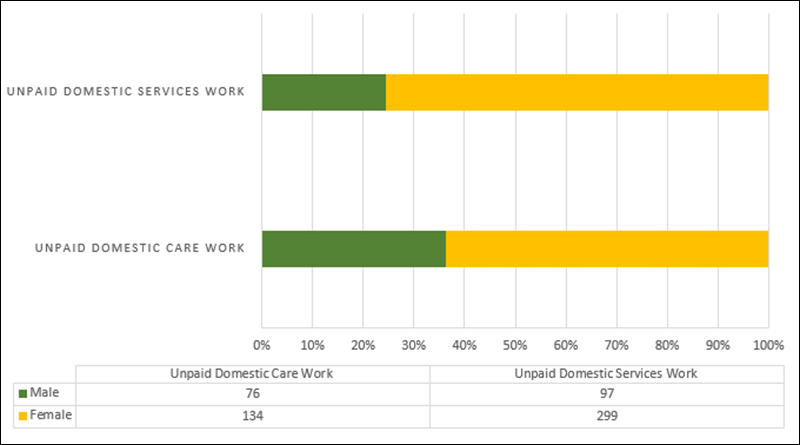
Source: Author’s own, data from India Time Use Survey 2019[32]
Time Poverty and Economic Participation: Theoretical Background and Empirical Evidence
Time-poor women are often constrained in terms of the amount of time they can attribute to paid work and, consequently, their choice of job opportunities or livelihood activities with economic returns. Figure 5 helps explain the economic logic behind women’s time-poverty-driving decisions regarding female labour participation rates in the Indian job market.
Figure 5: Labour Supply Curves for Men and Women
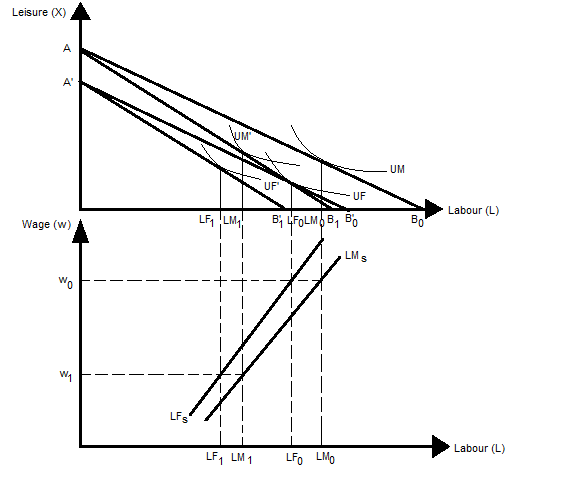
Source: Author’s own
Abstracting for any social biases, Indian men and women are considered as rational individuals seeking to optimally use their residual time in a day (after catering to their respective unpaid domestic services responsibilities) between economic activities such as labour (L) and other activities category, here referred to as leisure (X).[33] Both labour and leisure in this context are treated as normal goods—while labour contributes to economic wellbeing through income generation, leisure contributes to the individual’s social wellbeing.[34] As men and women seek to maximise their overall wellbeing through engagement in labour and leisure, they ultimately allocate their time between the two alternate activities in a manner that exhausts the entire residual time available to them in a day.[35] As such, individuals, therefore, maximise their overall wellbeing at their respective residual time budgets (denoted in Figure 5 by for males and for females at wage rate ). The residual time budget for women is significantly lower compared to men. This is because, a disproportionately larger percentage of Indian women spend a considerably higher share of their time on unpaid domestic service activities and are, therefore, time poor. Here, women’s time poverty is treated as synonymous with relative income poverty in poorer households with lower budgets for consumption expenditure. Accordingly, in this context, despite identical preferences denoted by the utility curves (UF for females and UM for males), women often allocate less time to both labour and leisure (compared to men) and, therefore, gain lower levels of wellbeing from these activities.
Here, represents the opportunity cost of time spent on leisure activities in purely economic terms. As the wage rates in labour markets decline, it is optimal for individuals to substitute leisure for labour to maximise their overall wellbeing. Therefore, at a lower wage rate , the residual time budgets are denoted in Figure 5 by for males and for females. As the wage rate declines, there is a decline in labour supply for both men and women. This aligns with the traditional theory of labour supply in input markets.[36] Here again, the residual time budget for women remains significantly lower compared to men, and women often end up allocating less time to both labour and leisure activities. The second graph in Figure 5, represents the labour supply in input markets at various wage rates. At any given wage rate, the female labour supply, denoted by is lower than men (demoted by ).
Indicatively, time spent by women on unpaid domestic service activities for themselves and other members of the household leads to a decline in female labour force participation rates in labour markets and lower female labour supply compared to men. Figure 6 below shows the daily minutes spent on water management-related unpaid domestic services by females aged between 15-59 years and the ratio of female-to-male labour force participation rates for the year 2019 across the Indian states and UTs.
Figure 6: Women’s time spent on water management-related unpaid domestic services and labour force participation in India (2019)
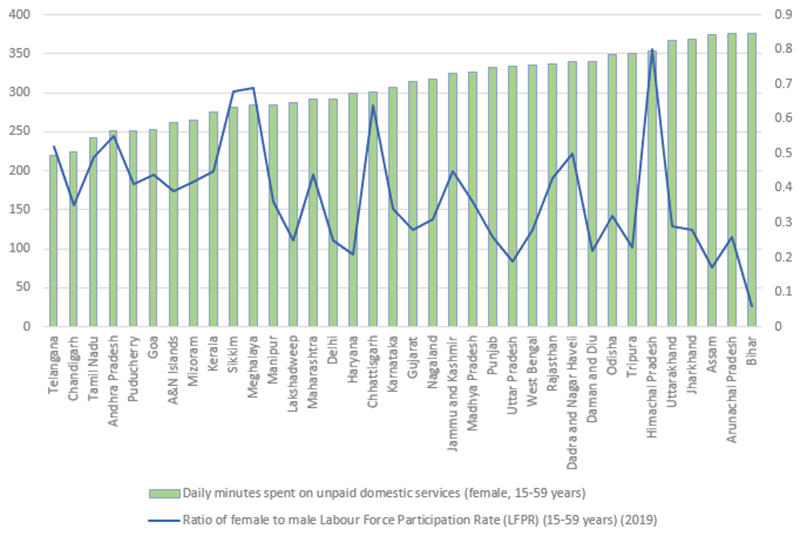
Source: Author’s own, data from India Time Use Survey 2019 [37]
Proposition: Regions where women spend significantly more time on these activities are likely to have a ratio lower female-to-male labour force participation rate.
This is true for the Indian case. Figure 7 shows the results of a simple correlation between the minutes spent in a day on an average per person in the water management-related unpaid domestic services for self and other household members (female, 15-59 years) and the ratio of female-to-male labour force participation rate (15-59 years) in 2019 across India’s states and UTs. With a moderately negative correlation, variations in women’s engagement in water management-related unpaid domestic services across India contribute to as much as a 17 percent variation in the labour force participation ratio (statistically significant at a 5 percent significance level).
Figure 7: Correlation between women’s time spent on water management-related unpaid domestic services and labour force participation ratio in India

Source: Author’s own, calculated on STATA 14 using data from India Time Use Survey 2019[38]
Corollary 1: To ensure gender equity in employment rates and promote women’s economic participation despite lower female labour force participation than men, it is necessary to incentivise women’s entry into labour markets with higher wage rates than men.
Even under the consideration of homogenous demand conditions in the Indian labour markets without any gender bias, this would translate into gender inequality in employment rates, with not enough women available to take up paid employment or livelihood opportunities at the prevailing market wages, as seen in Figure 8 (labour demand is denoted by ). Only at relatively higher wage rates can the income effect on women’s decision-making induce their entry into the labour force, albeit at the cost of the time allocated to other activities denoted as leisure (X) here. Time poverty due to disproportionate engagement in water management-related unpaid domestic services can be a significant reason behind higher female unemployment rates than for men in India, despite the female employability rate in the country being consistently higher for women than men.[39]
Figure 8: Representative employment scenario in Indian labour markets (with no demand segmentation)
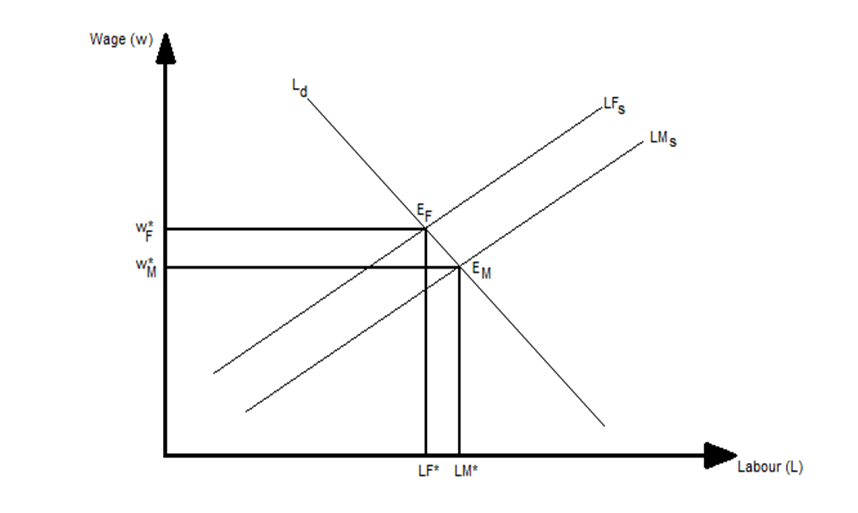
Source: Author’s own
Moreover, this also suggests that average wage rates for employed females should be higher than for men. However, the reality is otherwise. Women in India often tend to be overrepresented in unpaid self-employment and casual work in the National Sample Survey Organisation data, often characterised by lower wages and more precarious working conditions than their male counterparts.[40] The International Labour Organization refers to such conditions as "vulnerable employment," denoting precarious work without access to social protection and heightened susceptibility to economic downturns.[41] Unpaid family work is also categorised within this group, perpetuating a cycle of economic vulnerability for women. The over-representation of women in "marginal work" is deeply intertwined with various forms of paid and unpaid labour, characterised by extended working hours, flexible labour conditions, and shadow work, resulting in a skewed value distribution favouring a gender-induced wage disparity in Indian labour markets.[42] Therefore, women's employment issues are quantitatively and qualitatively different from those of their male counterparts. While the channels of transmission from time poverty to low female workforce participation and lower employment rates are more apparently visible, the marginalisation of the employed female workforce in India to low-paying jobs indicates that there is also significant gender-induced segmentation in labour demand in the Indian markets. Figure 9 below shows the daily minutes spent on water management-related unpaid domestic services by females aged between 15-59 years and the ratio of female-to-male wage rates for the year 2019 across the Indian states and UTs.
Figure 9: Women’s time spent on water management-related unpaid domestic services and wage ratio in India (2019)
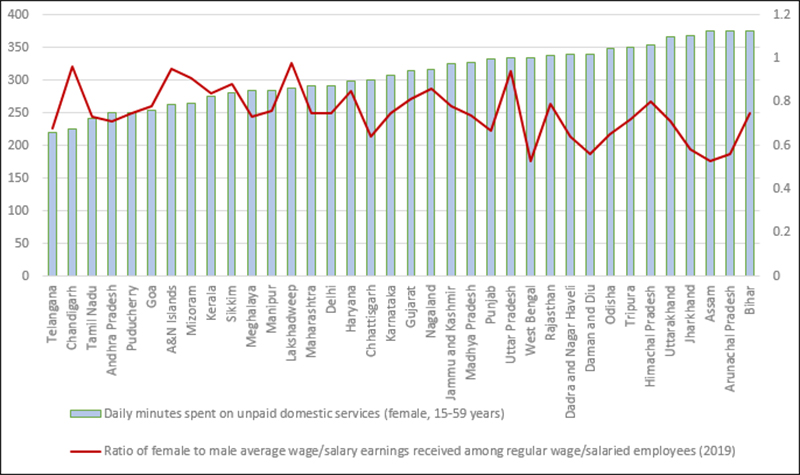
Source: Author’s own, data from India Time Use Survey 2019 [43]
Regions where women spend a significantly larger time on these activities also, on average, have a lower female-to-male wage ratio, as seen in the Indian case. Figure 10 below shows the results of a simple correlation between the minutes spent in a day on an average per person in the water management-related unpaid domestic services (female, 15-59 years) and the ratio of female to male average wage/salary earnings received among regular wage/salaried in 2019 across India’s states and UTs. With a moderately negative correlation, variations in women’s engagement in water management-related unpaid domestic services across India contribute to as much as a 23 percent variation in the female-to-male wage ratio (statistically significant at a 1 percent significance level).
Figure 10: Correlation between women’s time spent on water management-related unpaid domestic services and wage ratio in India

Source: Author’s own, calculated on STATA 14 using data from India Time Use Survey 2019[44]
Corollary 2: Gender-induced demand segmentation of the labour market in excess of the supply-side segmentation (where women have a relatively more active decision-making role as rational individuals) depresses women's wages and lowers female employment rates.
Figure 11 shows that under conditions where overall female workforce participation rates are lower compared to men, an equivalent demand segmentation based on gender contexts and realities (demand for male labourers is denoted by and demand for female labourers is denoted by ) leads to no gender pay gap. However, when the demand segmentation is more than the disparities in labour supply (as demoted by still lower demand for female labourers as in ), it results in a significant pay gap among men and women and overall lower levels of income for the female population in India.
Figure 11: Representative employment scenario in Indian labour markets (with demand segmentation)
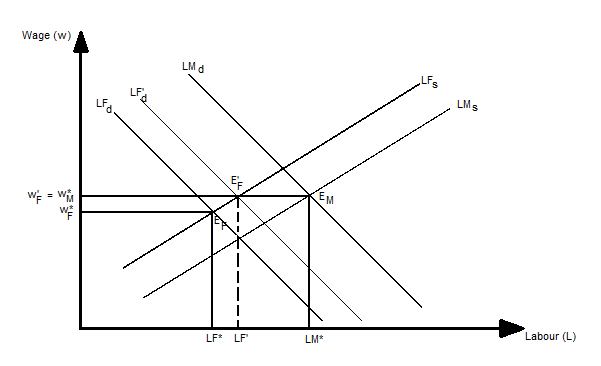
Source: Author’s own
While strategies such as flexible or part-time working hours and increased casualisation of jobs in specific sectors allow women to remain in the job market, they also reinforce the discriminatory wages and gender pay gap, leaving women worse -off in terms of both economic and social wellbeing.[45], [46] The unequal distribution of unpaid work, coupled with the challenges of the job market, continues to perpetuate gender disparities in employment and income. The undervaluation of female labour and dehumanising working conditions also exacerbate the gender inequalities persistent in the progress along various other targets enshrined under the sustainable development framework through various time and income poverty-linked pathways.[47],[48] It can introduce adverse impacts on achieving the Sustainable Development Goals (SDGs), particularly SD-1 (no poverty), SDG-2 (zero hunger), SDG-3 (good health and wellbeing), SDG-4 (quality education), SDG-5 (gender equality), SDG-8 (decent work and economic growth), and SDG-10 (reduced inequalities).
Estimating the Opportunity Costs for Women’s Time Poverty
Mitigating the excess burden of household-level water management on women and the resultant time poverty can accelerate progress towards addressing the complex web of factors contributing to gender disparities in employment and income. The following exercise attempts to estimate the additional annual income that can be generated per person across Indian states and UTs with varying degrees of efficiency in addressing women’s time poverty that can aid their participation in paid work. To provide an indicative valuation of the opportunity cost that women bear in terms of lost income due to the burden of water management-related unpaid domestic services, this paper estimates the annual additional income per person under different scenarios—a 10 percent, 20 percent, 30 percent, 40 percent, and 50 percent reduction in women’s daily hours spent on these activities, using the minimum wage rate for unskilled workers. Table 2 provides the range of estimated additional income that can be generated across Indian states and UTs with the mitigation of household-level gender disparities in the water sector (see appendix for estimates under each scenario).
Table 2: Estimated Annual Additional Income per Person with a 10-50 Percent Reduction in Women's Time Poverty
| States/UTs |
Daily hours spent on water management-related unpaid domestic services (female, 15-59 years) |
Minimum Wage Rate for Unskilled Workers (INR, per hour) |
Estimated Annual Additional Income per Person with a 10% - 50% Reduction in Women's Time Poverty (in INR) |
| Andaman and Nicobar Islands |
4.4 |
67.25 |
9,162 - 45,811 |
| Andhra Pradesh |
4.2 |
59.35 |
7,746 - 38,729 |
| Arunachal Pradesh |
6.3 |
31.73 |
6,204 - 31,020 |
| Assam |
6.3 |
44.45 |
8,668 - 43,341 |
| Bihar |
6.3 |
48.50 |
9,483 - 47,414 |
| Chandigarh |
3.8 |
60.69 |
7,100 - 35,502 |
| Chhattisgarh |
5.0 |
50.38 |
7,886 - 39,431 |
| Dadra and Nagar Haveli |
5.7 |
44.41 |
7,852 - 39,261 |
| Daman and Diu |
5.7 |
44.41 |
7,852 - 39,261 |
| Delhi |
4.9 |
82.86 |
1,2581 - 62,904 |
| Goa |
4.2 |
51.88 |
6,825 - 34,123 |
| Gujarat |
5.2 |
56.50 |
9,225 - 46,127 |
| Haryana |
5.0 |
50.64 |
7,873 - 39,366 |
| Himachal Pradesh |
5.9 |
54.09 |
9,956 - 49,781 |
| Jammu and Kashmir |
5.4 |
38.88 |
6,570 - 32,849 |
| Jharkhand |
6.2 |
43.25 |
8,299 - 41,496 |
| Karnataka |
5.1 |
69.35 |
1,1071 - 55,355 |
| Kerala |
4.6 |
57.77 |
8,291 - 41,455 |
| Lakshadweep |
4.8 |
50.13 |
7,481 - 37,403 |
| Madhya Pradesh |
5.5 |
46.39 |
7,889 - 39,444 |
| Maharashtra |
4.9 |
61.05 |
9,270 - 46,351 |
| Manipur |
4.8 |
32.45 |
4,809 - 24,047 |
| Meghalaya |
4.7 |
47.63 |
7,033 - 35,166 |
| Mizoram |
4.4 |
52.50 |
7,235 - 36,173 |
| Nagaland |
5.3 |
25.38 |
4,184 - 20,922 |
| Odisha |
5.8 |
43.13 |
7,826 - 39,132 |
| Puducherry |
4.2 |
33.41 |
4,361 - 21,806 |
| Punjab |
5.6 |
49.78 |
8,620 - 43,098 |
| Rajasthan |
5.6 |
32.38 |
5,673 - 28,367 |
| Sikkim |
4.7 |
62.50 |
9,133 - 45,663 |
| Tamil Nadu |
4.0 |
49.87 |
6,275 - 31,375 |
| Telangana |
3.7 |
59.46 |
6,802 -34,012 |
| Tripura |
5.9 |
34.99 |
6,386 - 31,928 |
| Uttar Pradesh |
5.6 |
48.50 |
8,424 - 42,122 |
| Uttarakhand |
6.1 |
47.55 |
9,075 - 45,375 |
| West Bengal |
5.6 |
47.04 |
8,194 - 40,971 |
Source: Author’s calculations, data from India Time Use Survey 2019 and Simpliance[49], [50]
Table 2 provides conservative estimates of additional income generation potential across states and UTS. Incorporating minimum wage rates across higher skill levels and prevailing market wages can lead to higher valuation. Only the lower five deciles of efficiency in plausible reductions in women’s engagement in these activities are considered in recognition that a critical minimum engagement in domestic services is necessary for all household members. However, the analysis can be easily extended to account for further improvements. The additional income generation at the household level is of immense significance in spurring growth in consumption expenditure (in the short and medium term)[51] and investments in social sectors such as children’s health and education, often prioritised by women of the households.[52],[53] This, in turn, can contribute significantly to sustainable economic growth in respective states and UTs.[54]
Addressing gender disparities in household-level water management, however, at the outset, requires a holistic understanding of social and economic factors that perpetuate women’s extensive engagement in such activities and the implications it has on their economic and social wellbeing. Policy frameworks must recognise and acknowledge the multifaceted impact of women’s unpaid work in the household water sector and adopt strategies for gender mainstreaming these considerations into the overall framework. A cost-benefit analysis that compares the economic costs associated with investments and planning related to gender mainstreaming in water resources management and the tangible economic benefits of addressing the existing gender disparities with varying degrees of efficiency can enable stakeholders at various levels of governance, including governments, civil society organisations, the private sector, communities, and individuals in more effective design, implementation, monitoring and evaluation of policies, programmes, and practices and create scope for mitigating the gender disparities emanating from the water sector.
Promoting Inclusion in Water Resource Management
Effective strategies to overcome barriers and promote gender inclusion in water resource management should encompass a multifaceted approach, addressing institutional, community, and policy levels to ensure equitable and sustainable water governance.
- Promoting Women's Participation in Water Governance at an Institutional Level: India’s water policies until 2012 were largely gender blind. Therefore, a foundational strategy in achieving gender-responsive water resource management is to promote women's active participation in institutional decision-making processes to enable gender mainstreaming at an institutional level. This involves creating opportunities for women to join water management committees and boards, ensuring their voices are heard in the planning and implementing of water policies and projects, and creating a space for gender budgeting for water sector public investments.[55]
- Empowering Women as Decision-Makers in Ground-Level Water Management: To ensure that gender inclusivity extends beyond the boardroom, it is essential to empower women as decision-makers at the grassroots level. Encouraging women to take leadership roles in local water management initiatives enhances their agency and brings fresh perspectives and solutions to the table.[56]
- Capacity Building, Awareness, and Policy Support: Capacity building programmes tailored for women are instrumental in enhancing their effectiveness in water management. These programmes provide training in water-use efficiency, empowering women with the skills and knowledge needed to enable optimal use of available resources. Tailored training programmes for women should focus on skill development for efficient water management with minimal time or opportunity costs. These programmes should equip women with the tools and knowledge needed to optimise their water-related tasks, ultimately improving their quality of life. Simultaneously, raising awareness in community and policy circles about women's critical role in water resource management and its economic implications is pivotal, as it fosters a broader understanding of the gender dynamics in this domain. Supportive policies that acknowledge and address these gender disparities can further reinforce these efforts.
- Monitoring and Evaluating Water Management Practices from a Gender-Responsive Lens: To track progress and ensure gender-responsiveness, it is imperative to implement monitoring and evaluation mechanisms. Regular assessments from a gender perspective can identify gaps and opportunities for improvement in water management practices. Collecting and analysing gender-disaggregated data is fundamental in understanding the participation of women in water resource management at the household and community levels.[57] Such data helps identify specific challenges and disparities, paving the way for targeted interventions.
- Grants and Subsidies for Gender-Balanced Participation: Community-led organisations that prioritise gender balance in water resource management should be incentivised through grants and subsidies. These financial mechanisms reduce the burden on women and mitigate time poverty by enabling more equitable participation.
- Public Investments and Progressive Tax Structures: Public investments aimed at improving regular water access at the household level are crucial. Coupled with a progressive tax structure that encourages sustainable water consumption, these measures alleviate the disproportionate responsibility often placed on women for water collection and management. The Drink From Tap Mission (24x7 metred water supply) launched by the Odisha government in 2020 to provide safe and continuous drinking water to urban residents is an example of how public investments at the lowest effective governmental level can be linked to the downward accountability of constituents.[58]
- Promoting Women's Employment in the Water Sector: Creating viable employment opportunities for women in the water sector enhances their economic empowerment and fosters gender mainstreaming in integrated water resources management. This approach ensures that women’s otherwise unpaid engagement in water resources management is transformed into viable employment or livelihood opportunities, generating scope for their economic empowerment and sustainable development. Women professionals in the water sector are scarce mainly due to the existing gender gap in STEM fields. Closing this gap can facilitate women’s entry into the sector, enabling them to take on roles such as water entrepreneurs.
- Public-Private Partnerships for Gender-Responsive Projects: Leveraging public-private partnerships can be instrumental in advancing gender-responsive water management projects. Collaboration between governmental agencies, private sector entities, or civil society organisations can lead to innovative solutions, increased investment, localisation in project design and implementation, and enhanced project sustainability.[59]
The strategies outlined here represent a comprehensive approach to overcoming barriers and promoting gender inclusion in water resource management. Implementing these measures can advance equity, sustainability, and resilience in India’s water management practices while ensuring that women in the country no longer shoulder a double burden and bear the significant opportunity costs associated with their extensive water management responsibilities.
Conclusion
The intricate interplay between gender roles in water management and the broader economic landscape in India is undeniable. Gender imbalances in water management have ripple effects on the Indian labour market. Time-poor women, burdened by household responsibilities and employment, often participate in the labour market in a limited capacity. This results in a lower female labour supply than men, even at similar wage rates, leading to unambiguously lower female employment rates. Furthermore, the gender pay gap in Indian labour markets further highlights the economic consequences of women's time poverty. It indicates that women's limited availability for full-time employment leads to demand segmentation, with employers offering lower wages to women. This pay gap further widens the gender-based disparities in the Indian landscape. In essence, addressing gender disparities in water management is a matter of social equity and an economic imperative. Empowering women in this vital sector can enhance the efficiency of water projects, ultimately contributing to economic growth and reducing time poverty, which is a critical step toward achieving gender equality in the labour market. Recognising and addressing these issues at their core is essential to make India equitable and economically vibrant.
Moreover, as systemic challenges and gender imbalances in water management persist, hindering the full realisation of women's economic potential, the scarcity of women water professionals and representation at higher levels of governance in this sector—shaped by cultural biases, limited educational opportunities, and societal norms—continues to be a significant barrier to gender mainstreaming in policy frameworks. Empowering women in water governance is not merely a matter of social or economic justice; it can be a strategic move towards improving the efficiency and effectiveness of water projects. Their deep-rooted knowledge and pivotal role in household water management make them indispensable stakeholders in community-based initiatives and across various levels of water governance. The success of programmes like Atal Bhujal Yojana and the Uttarakhand Rural Water Supply and Sanitation Project underscores the transformative impact of women's involvement in water management and build a strong case advocating for gender mainstreaming and gender representation in India’s water sector.[60]
Appendix: Estimated Annual Additional Income per Person under Different Scenarios of Reduction in Women's Time Poverty
| States/UTs |
Additional Annual Income Generated per Person with a 10% Reduction in Time Poverty (in INR) |
Additional Annual Income Generated per Person with a 20% Reduction in Time Poverty (in INR) |
Additional Annual Income Generated per Person with a 30% Reduction in Time Poverty (in INR) |
Additional Annual Income Generated per Person with a 40% Reduction in Time Poverty (in INR) |
Additional Annual Income Generated per Person with a 50% Reduction in Time Poverty (in INR) |
| Andaman and Nicobar Islands |
9162 |
18324 |
27486 |
36649 |
45811 |
| Andhra Pradesh |
7746 |
15492 |
23238 |
30983 |
38729 |
| Arunachal Pradesh |
6204 |
12408 |
18612 |
24816 |
31020 |
| Assam |
8668 |
17336 |
26005 |
34673 |
43341 |
| Bihar |
9483 |
18965 |
28448 |
37931 |
47414 |
| Chandigarh |
7100 |
14201 |
21301 |
28402 |
35502 |
| Chhattisgarh |
7886 |
15772 |
23659 |
31545 |
39431 |
| Dadra and Nagar Haveli |
7852 |
15704 |
23556 |
31409 |
39261 |
| Daman and Diu |
7852 |
15704 |
23556 |
31409 |
39261 |
| Delhi |
12581 |
25162 |
37742 |
50323 |
62904 |
| Goa |
6825 |
13649 |
20474 |
27299 |
34123 |
| Gujarat |
9225 |
18451 |
27676 |
36901 |
46127 |
| Haryana |
7873 |
15747 |
23620 |
31493 |
39366 |
| Himachal Pradesh |
9956 |
19913 |
29869 |
39825 |
49781 |
| Jammu and Kashmir |
6570 |
13140 |
19710 |
26280 |
32849 |
| Jharkhand |
8299 |
16598 |
24897 |
33196 |
41496 |
| Karnataka |
11071 |
22142 |
33213 |
44284 |
55355 |
| Kerala |
8291 |
16582 |
24873 |
33164 |
41455 |
| Lakshadweep |
7481 |
14961 |
22442 |
29923 |
37403 |
| Madhya Pradesh |
7889 |
15778 |
23667 |
31556 |
39444 |
| Maharashtra |
9270 |
18541 |
27811 |
37081 |
46351 |
| Manipur |
4809 |
9619 |
14428 |
19238 |
24047 |
| Meghalaya |
7033 |
14067 |
21100 |
28133 |
35166 |
| Mizoram |
7235 |
14469 |
21704 |
28938 |
36173 |
| Nagaland |
4184 |
8369 |
12553 |
16738 |
20922 |
| Odisha |
7826 |
15653 |
23479 |
31305 |
39132 |
| Puducherry |
4361 |
8722 |
13083 |
17445 |
21806 |
| Punjab |
8620 |
17239 |
25859 |
34478 |
43098 |
| Rajasthan |
5673 |
11347 |
17020 |
22694 |
28367 |
| Sikkim |
9133 |
18265 |
27398 |
36530 |
45663 |
| Tamil Nadu |
6275 |
12550 |
18825 |
25100 |
31375 |
| Telangana |
6802 |
13605 |
20407 |
27210 |
34012 |
| Tripura |
6386 |
12771 |
19157 |
25542 |
31928 |
| Uttar Pradesh |
8424 |
16849 |
25273 |
33697 |
42122 |
| Uttarakhand |
9075 |
18150 |
27225 |
36300 |
45375 |
| West Bengal |
8194 |
16388 |
24582 |
32776 |
40971 |
Source: Author’s calculations
Endnotes
[a] According to the activity group classification under major divisions of the TUS survey, group 242 refers to “fetching water from natural and other sources for own final use”, and group 325 refers to “tending furnace, boiler, fireplace for heating and water supply”.
[1] A.K. Biswas and C. Tortajada, "Changing Global Water Management Landscape," in Water Management in 2020 and Beyond, Water Resources Development and Management, eds. A.K. Biswas, C. Tortajada, and R. Izquierdo, Berlin, Heidelberg: Springer, 2009, https://doi.org/10.1007/978-3-540-89346-2_1.
[2] Seema Kulkarni, “Women and Decentralised Water Governance: Issues, Challenges and the Way Forward,” Economic & Political Weekly, 46 (18): 64–72, April 2011,
https://genderandsecurity.org/projects-resources/research/women-and-decentralized-water-governance-issues-challenges-and-way.
[3] Maithreyi Krishnaraj, “Women and Water: Issues of Gender, Caste, Class and Institutions,” Economic & Political Weekly, 46 (18): 64–72, April 2011, https://www.indiawaterportal.org/articles/women-and-water-collection-papers-economic-and-political-weekly-volume-xlvi-number-18-0.
[4] Maithreyi Krishnaraj, “Women and Water: Issues of Gender, Caste, Class and Institutions”
[5] World Bank, "Water Resources Management," https://www.worldbank.org/en/topic/waterresourcesmanagement#2.
[6] National Water Mission, "Women Water Compendium," July 2021, https://nwm.gov.in/sites/default/files/Women%20Water%20Compendium_July%2021.pdf.
[7] Varsha Khandker, Vasant P. Gandhi, and Nicky Johnson, "Gender Perspective in Water Management: The Involvement of Women in Participatory Water Institutions of Eastern India," Water 12, no. 1 (2020): 196, https://doi.org/10.3390/w12010196.
[8] Asian Development Bank, Balancing the Burden? Desk Review of Women’s Time Poverty and Infrastructure in Asia and the Pacific, December 2015, https://www.adb.org/publications/balancing-burden-womens-time-poverty-and-infrastructure.
[9] Food and Agriculture Organization of the United Nations, "Chapter 6: Gender and Food Security: Agriculture," https://www.fao.org/3/x0171e/x0171e06.htm#P424_56349.
[10] Sharon B. Medgal, Susanna Eden and Eylon Shamir, “Water Governance, Stakeholder Engagement, and Sustainable Water Resources Management,” Water 2017, no. 3 (2017), https://doi.org/10.3390/w9030190.
[11] Malin Falkenmark, "The Massive Water Scarcity now Threatening Africa: Why isn't it Being Addressed," Ambio 18, no. 2 (1989): 112-118, https://www.jstor.org/stable/4313541.
[12] RiteWater, "Water Management in Rural India: Scope, Challenges, Solutions," https://www.ritewater.in/water-management-in-rural-india-scope-challenges-solutions/.
[13] RiteWater, "Water Management in Rural India: Scope, Challenges, Solutions”
[14] UN Women, "Issue Brief: Gender-Responsive Water and Sanitation Systems," https://www.unwomen.org/en/digital-library/publications/2018/6/issue-brief-gender-responsive-water-and-sanitation-systems.
[15] Els Lecoutere, Ben D'Exelle and Bjorn Van Campenhout, “Sharing Common Resources in Patriarchal and Status-Based Societies: Evidence from Tanzania,” Feminist Economics, no. 3 (2015), https://doi.org/10.1080/13545701.2015.1024274
[16] World Resources Institute, "Women Are Secret Weapon for Better Water Management," https://www.wri.org/insights/women-are-secret-weapon-better-water-management.
[17] United Nations Development Programme, "Women Water Champions," https://www.undp.org/india/publications/women-water-champions.
[18] Nandita Singh, “The Changing Role of Women in Water Management: Myths and Realities,” Wagadu: a Journal of Transnational Women's & Gender Studies, no. 3 (2006), https://sh.diva-portal.org/smash/record.jsf?pid=diva2%3A1628434&dswid=-7684
[19] Ministry of Statistics and Programme Implementation, "Report on Time Use Survey 2019," 2019, https://www.mospi.gov.in/sites/default/files/publication_reports/Report_TUS_2019_0.pdf?download=1.
[20] Itishree Pattnaik and Kuntala Lahiri-Dutt, “What determines women's agricultural participation? A comparative study of landholding households in rural India,” Journal of Rural Studies, no. 76 (2020), https://www.sciencedirect.com/science/article/abs/pii/S0743016718305631
[21] Shweta Sengar, “'Water Wives': How Lack Of Water In This Maharashtra Village Led To Polygamy,” India Times, April 27, 2022, https://www.indiatimes.com/news/india/water-wives-how-lack-of-water-in-this-maharashtra-village-led-to-polygamy-568090.html.
[22] Ministry of Statistics and Programme Implementation, "Report on Time Use Survey 2019”
[23] Ministry of Statistics and Programme Implementation, "Report on Time Use Survey 2019”
[24] Ministry of Statistics and Programme Implementation, "Report on Time Use Survey 2019”
[25] Ministry of Statistics and Programme Implementation, "Report on Time Use Survey 2019”
[26] Ministry of Statistics and Programme Implementation, "Report on Time Use Survey 2019”
[27] Puja Das, "Universal Tap Water Coverage Could Save 400,000 Lives, $101 Bn in Costs for India: WHO," LiveMint, June 10, 2023, https://www.livemint.com/news/india/universal-tap-water-coverage-could-save-400-000-lives-101-bn-in-costs-for-india-who-11686378183020.html.
[28] Ministry of Statistics and Programme Implementation, "Report on Time Use Survey 2019”
[29] Lan Mercado, Mohammad Naciri, and Yamini Mishra, "Women’s Unpaid and Underpaid Work in Times of COVID-19," Amnesty International, June 01, 2020, https://www.amnesty.org/en/latest/campaigns/2020/06/womens-unpaid-and-underpaid-work-in-times-of-covid19/.
[30] Syamantak Chattopadhyay and Subhanil Chowdhury, "Female Labour Force Participation in India: An Empirical Study," The Indian Journal of Labour Economics, volume 65, pages59–83 (2022), https://doi.org/10.1007/s41027-022-00362-0.
[31] Pushpendra Singh and Falguni Pattanaik, "Unfolding unpaid domestic work in India: women’s constraints, choices, and career," Palgrave Communications, volume 6, Article number: 111 (2020), https://doi.org/10.1057/s41599-020-0488-2.
[32] Ministry of Statistics and Programme Implementation, "Report on Time Use Survey 2019”
[33] Gary S. Becker, "A Theory of the Allocation of Time," The Economic Journal, 75, no. 299 (1965): 493–517, https://doi.org/10.2307/2228949.
[34] Dan Cui, Xiang Wei, Dianting Wu, Nana Cui, and Peter Nijkamp, "Leisure time and labor productivity: a new economic view rooted from sociological perspective," Economics: The Open-Access, Open-Assessment E-Journal, 13 (2019-36): 1–24, http://dx.doi.org/10.5018/economics-ejournal.ja.2019-36.
[35] Gary S. Becker, “A Theory of the Allocation of Time”
[36] Gary S. Becker, “A Theory of the Allocation of Time”
[37] Ministry of Statistics and Programme Implementation, "Report on Time Use Survey 2019”
[38] Ministry of Statistics and Programme Implementation, "Report on Time Use Survey 2019”
[39] "Indian Women Are More Employable Than Men; Guess How Many Are in the Workforce," Economic Times, December 29, 2022, https://economictimes.indiatimes.com/jobs/indian-women-are-more-employable-than-men-guess-how-many-are-in-the-workforce/articleshow/96596276.cms.
[40] Steven Kapsos, Andrea Silberman, and Evangelia Bourmpoula, "Why is Female Labour Force Participation Declining Sharply in India?" International Labour Office ILO Research Paper No. 10 (August 2014), https://www.ilo.org/wcmsp5/groups/public/---dgreports/---stat/documents/publication/wcms_631497.pdf.
[41] Steven Kapsos, Andrea Silberman, and Evangelia Bourmpoula, "Why is Female Labour Force Participation Declining Sharply in India?"
[42] Praveen Jha, Avinash Kumar and Yamini Mishra, Labouring women: issues and challenges in contemporary India, Hyderabad Orient BlackSwan (2020), https://vslopac.iima.ac.in/cgi-bin/koha/opac-detail.pl?biblionumber=216408
[43] Ministry of Statistics and Programme Implementation, "Report on Time Use Survey 2019”
[44] Ministry of Statistics and Programme Implementation, "Report on Time Use Survey 2019”
[45] Claudia Goldin, "Hours Flexibility and the Gender Gap in Pay," Center for American Progress, April 15, 2015, https://www.americanprogress.org/article/hours-flexibility-and-the-gender-gap-in-pay-2/.
[46] Maria E Canon and Limor Golan, "Gender Pay Gap May Be Linked to Flexible and Irregular Hours," Federal Reserve Bank of St. Louis, July 14, 2016, https://www.stlouisfed.org/publications/regional-economist/july-2016/gender-pay-gap-may-be-linked-to-flexible-and-irregular-hours.
[47] UN Women, Progress on the Sustainable Development Goals: The Gender Snapshot 2021, United Nations (2021), https://www.unwomen.org/en/digital-library/publications/2021/09/progress-on-the-sustainable-development-goals-the-gender-snapshot-2021.
[48] International Labour Organization, "Progress and Challenges in Closing the Gender Pay Gap and other Gender-based Gaps within the 2030 Agenda for Sustainable Development Framework," 19th American Regional Meeting, October 2018, https://www.ilo.org/global/docs/WCMS_645428/lang--en/index.htm.
[49] Ministry of Statistics and Programme Implementation, "Report on Time Use Survey 2019”
[50] https://www.simpliance.in/minimum-wages
[51] Perez-Montiel, Jose, and Carles Manera Erbina, "Investment Sustained by Consumption: A Linear and Nonlinear Time Series Analysis," Sustainability, 11, no. 16 (2019): 4381, https://doi.org/10.3390/su11164381
[52]Gary S. Becker and Nigel Tomes, "Human capital and the rise and fall of families," Journal of labor economics, 4, no. 3, Part 2 (1986): S1-S39, https://www.journals.uchicago.edu/doi/abs/10.1086/298118
[53] “Investing in Women and Girls”, The Organisation for Economic Co-operation and Development, https://www.oecd.org/dac/gender-development/investinginwomenandgirls.htm
[54] Perez-Montiel, Jose, and Carles Manera Erbina, "Investment Sustained by Consumption: A Linear and Nonlinear Time Series Analysis"
[55] Imrana Jalal, "Women, Water, and Leadership," ADB Briefs No. 24, Asian Development Bank, December 2014, https://www.adb.org/publications/women-water-and-leadership.
[56] "Promoting Women's Participation in Water Resource Management in Central Asia," World Bank, January 20, 2021, https://www.worldbank.org/en/news/feature/2021/01/20/promoting-womens-participation-in-water-resource-management-in-central-asia.
[57] Joni Seager, "Sex-disaggregated indicators for water assessment monitoring and reporting," Technical Paper, Gender and Water Series, WWAP, UNESCO, 2015, https://unesdoc.unesco.org/ark:/48223/pf0000234082.locale=en.
[58] Government of Odisha, “Drink from Tap Mission: Pure for Sure,” Water Corporation of Odisha, August 2019, https://urban.odisha.gov.in/sites/default/files/2023-03/Drink-From-Tap-Mission.pdf.
[59] World Economic Forum, "Strengthening Public-Private Cooperation with Civil Society," White Paper, January 2023, https://www3.weforum.org/docs/WEF_Strengthening_Public_Private_Cooperation_with_Civil_Society_2022.pdf.
[60] “How is India addressing its water needs?,” World Bank Briefs, February 14, 2023, World Bank, https://www.worldbank.org/en/country/india/brief/world-water-day-2022-how-india-is-addressing-its-water-needs
The views expressed above belong to the author(s). ORF research and analyses now available on Telegram! Click here to access our curated content — blogs, longforms and interviews.

 PDF Download
PDF Download

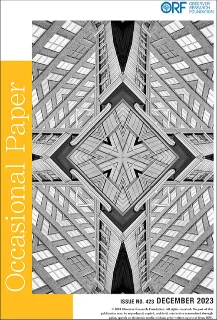













 PREV
PREV


